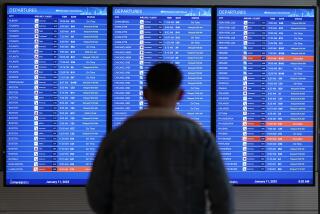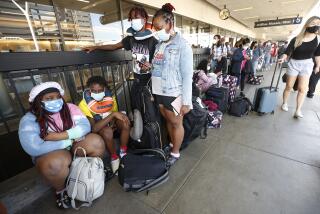Airline delays decline, but there’s a catch to those numbers
Airline delays and cancellations have dropped significantly in the last few years. At least that’s what federal statistics show. But the numbers may not be telling us the whole story.
That is one of the conclusions in a new report by the office of inspector general for the U.S. Department of Transportation, which recommends new ways of calculating airline delays.
The Department of Transportation’s data show that airline delays fell 33% from 2000 to 2012, while flight cancellations dropped 56% at the nation’s largest airports.
The problem with the numbers, according to the inspector general, is that the Department of Transportation looks at flight data only from the 16 largest airlines. Those airlines account for about 76% of domestic flights. The other 24% are not calculated in the federal analysis.
The nation’s “published flight delay data present the public with an incomplete picture of the number of delays that actually occur at a given airport or are generated by all carriers,” the report said.
Another reason the numbers don’t give an exact picture, the report says, is that most major airlines have increased their scheduled gate-to-gate time for nearly every flight, giving themselves a cushion to absorb delays.
In 2000, the time that airlines scheduled for a flight exceeded the actual flight time on 73% of routes analyzed by the office of inspector general. By 2012, this rate had grown to 98% of all routes. One example cited by the study was a LaGuardia-to-Indianapolis route — typically a 21/2-hour flight. From 2000 to 2012, airlines have increased the scheduled flight time by 21 minutes, the report found.
Airlines say that they don’t inflate the scheduled flight time to avoid delays but try to be realistic about the time each flight needs.
“Airline scheduling is based on the realities of the air travel system, taking into account conditions such as airspace and ground congestion or weather that can impact gate-to-gate time,” said Vaughn Jennings, a spokesman for Airlines for America, the trade group for the nation’s airlines.
Hotel mini bar an endangered species
Is it time to say goodbye to the hotel mini bar?
A recent survey by the travel website TripAdvisor.com found that the hotel mini bar was the least important amenity for U.S. travelers. Only 21% of travelers ranked the mini bar as an important amenity, compared to 89% who called free in-room wireless Internet the most important.
There is little financial reason to keep mini bars. Hotel consulting firms estimate that mini bars generate no more than 0.24% of total hotel revenue, with much of that eaten up by the cost to check and restock the bars.
Companies that build and sell automated mini bars that electronically charge guests when a drink or snack is removed from the bar say they can cut the labor costs up to 60%.
Still, industry experts say mini bars won’t be around for long.
Many hotels don’t offer them because of the hassle of restocking and the disputes with guests over mini bar fees, said Lynn Mohrfeld, president of the California Hotel and Lodging Assn.
“They are a very difficult amenity to manage,” he said.
But the future of mini bars is bleak mostly because of social trends that have pushed travelers into the lobbies to socialize and surf the Web, instead of sitting alone in their rooms, eating mini bar food, said David Corsun, director and associate professor at the Knoebel School of Hospitality Management at the University of Denver.
It’s the same reason some hotels are eliminating room service and beefing up the food and drink offerings in the lobby, Corsun said.
“People are migrating out of their rooms rather than being in the rooms,” he said.
More to Read
Sign up for Essential California
The most important California stories and recommendations in your inbox every morning.
You may occasionally receive promotional content from the Los Angeles Times.











